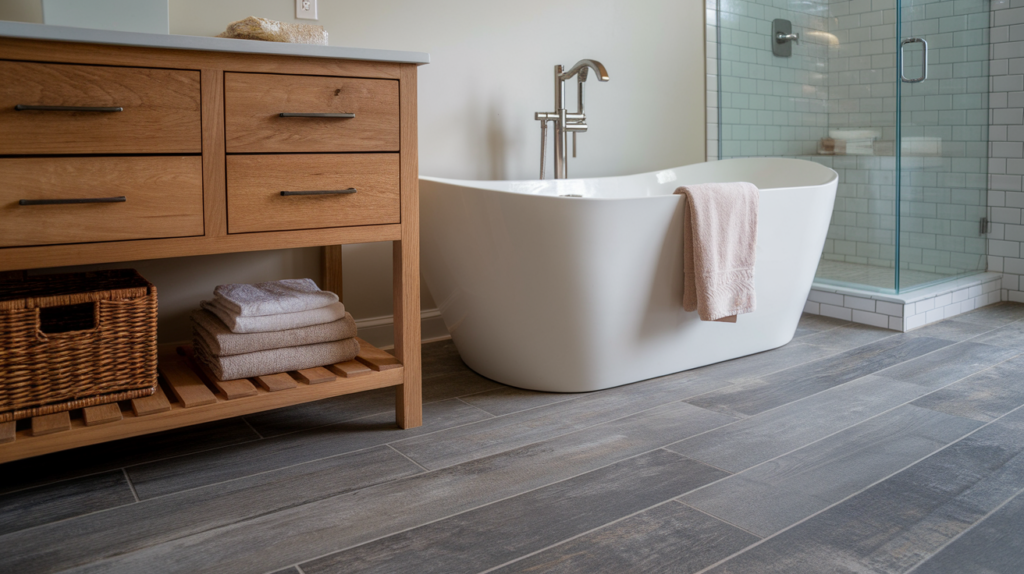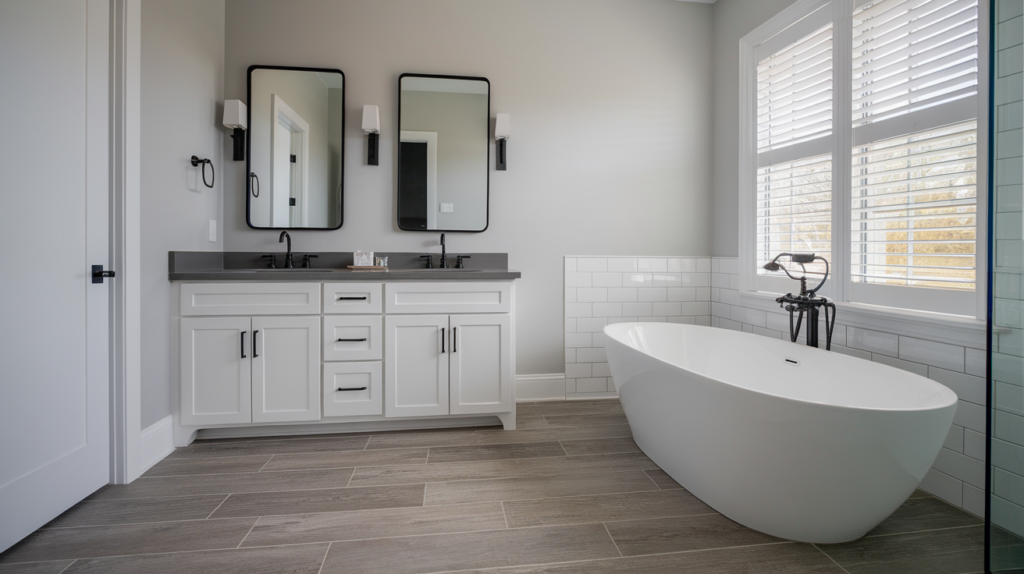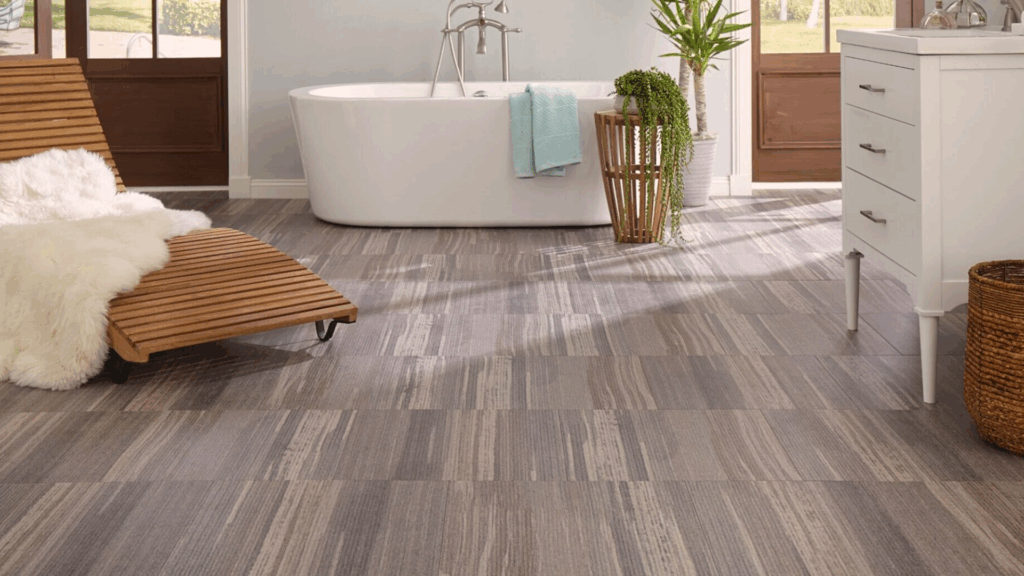Picking the right bathroom floor can drive you crazy. Water, spills, humidity, and constant foot traffic make this decision critical.
You want a floor that looks great, stays within budget, and survives daily bathroom chaos. Enter vinyl flooring – a potential game-solver for your bathroom renovation puzzle.
My guide will help you:
- Understand vinyl flooring’s pros and cons
- Compare vinyl to traditional ceramic tile
- Make a smart choice for your bathroom
I’ve spent years helping homeowners tackle tricky flooring decisions. My research and experience will cut through the confusion, giving you clear, practical advice.
By the end of this blog, you’ll know exactly whether vinyl flooring is the right fit for your bathroom’s unique needs.
Understanding Vinyl Flooring for Bathrooms
Let’s get real about vinyl flooring. It’s not the same old stuff your grandparents had. Vinyl comes in three main types:
- Sheet vinyl: One continuous roll of flooring
- Luxury Vinyl Tile (LVT): Looks like individual tiles
- Vinyl Plank: Mimics wooden planks
For bathrooms, luxury vinyl tile (LVT) and vinyl planks are my top picks. Why? They’re water-resistant superstars that look surprisingly good.
Imagine flooring that can handle water fights, wet towels, and morning shower splashes without freaking out. That’s modern vinyl for you.
When I first started researching bathroom floors, I was shocked. Vinyl has turned from cheap-looking sheets to high-end flooring that can fool most people.
Today’s vinyl isn’t just water-resistant – it’s practically a bathroom superhero. Want specifics? LVT gives you the look of ceramic or stone without the cold, hard feel.
Vinyl planks bring warmth that tile can’t match. Both laugh in the face of moisture, making them perfect for bathrooms where water is always trying to cause trouble.
The best part? You get style, durability, and protection – without breaking the bank.
Pros of Using Vinyl Flooring in Bathrooms

Not all flooring is created equal. Vinyl brings some serious advantages to your bathroom that might just blow your mind.
1. Water-Resistant Wonder
Water is a bathroom’s worst enemy. One wrong move, and you’re looking at expensive damage. Vinyl laughs in the face of moisture.
Whether it’s shower splashes, wet towels, or those morning routine water fights, this flooring stands its ground. I’ve seen vinyl handle water like a champ, protecting your subfloor from potential water damage.
2. Budget-Friendly Brilliance
Bathroom remodels can drain your wallet faster than a leaky faucet. Vinyl is the budget hero you’ve been waiting for.
Compared to ceramic tile or stone, you’ll save big without sacrificing style. Want a wood look? Vinyl’s got you covered at a fraction of the cost.
3. Comfort Underfoot
Remember those cold, hard tile floors that shock your bare feet in the morning? Vinyl is different. It’s softer, warmer, and more forgiving.
Your feet will thank you every single morning when you step out of the shower. No more wincing at icy-cold surfaces!
4. Cleaning Made Simple
Forget spending hours scrubbing grout lines. Vinyl is a cleaning dream. A quick mop or sweep, and you’re done.
No special cleaners, no backbreaking scrubbing. I used to spend weekends cleaning my old tile bathroom – now, it’s a five-minute job with vinyl.
5. Style Galore
Boring bathroom? Not anymore. Vinyl comes in more styles than you can imagine. Wood-look planks, stone-like tiles, modern patterns – the options are endless.
Want a rustic cabin feel? Done. Sleek modern design? You got it. Vinyl lets you express your personal style without breaking the bank.
Pro tip: Your bathroom can look like a million-dollar renovation, but your wallet will keep its little secret.
Cons of Vinyl Flooring in Bathrooms
Vinyl flooring might seem like a budget-friendly option, but it comes with several significant drawbacks when used in bathrooms. These are some key concerns to consider:
1. Durability Challenges
Drop something heavy, and vinyl might cry. I learned this the hard way. A dropped hair dryer or heavy shampoo bottle can leave a permanent dent or tear.
Unlike tough ceramic tile, vinyl is more sensitive to impacts. Your bathroom’s high-traffic zone might show wear faster than you’d like.
2. Quality Matters
Not all vinyl is created equal. Cheap options can betray you. Over time, low-quality vinyl might start peeling at the edges or corners.
It’s like a bad haircut that slowly reveals its true nature. I’ve seen bathrooms where cheap vinyl looked terrible after just a few years.
3. Resale Value Concerns
Your beautiful vinyl floor might not impress future home buyers. Ceramic tile still wins the resale value game.
When I was selling my previous home, real estate agents noted that high-end tile tends to attract more buyers than vinyl flooring.
4. Environmental Impact
Let’s get real about sustainability. Vinyl is basically plastic’s cousin – not great for the planet. Made from synthetic materials, it’s tough to recycle.
If you’re eco-conscious, this might keep you up at night. Traditional materials like stone or ceramic have a lower environmental footprint.
5. Subfloor Sensitivity
Water is vinyl’s frenemy. One wrong move, and you’re in trouble. Your subfloor needs to be perfectly sealed and prepared.
Any moisture trapped underneath can cause serious damage. I’ve seen bathrooms where improper installation led to hidden water damage – and trust me, that’s a nightmare you don’t want.
Vinyl Flooring: Installation and Maintenance Tips
Vinyl flooring offers a budget-friendly and versatile option for homes. Proper installation and care can significantly extend its lifespan and maintain its appearance.
1. Prep Like a Pro
Your floor’s success starts before the first tile touches the ground. I’ve seen too many DIY disasters from skipping this step. Clean your subfloor until it’s spotless – and I mean spotless.
Any bumps, dirt, or uneven spots will show through your new vinyl. Imagine trying to put a smooth tablecloth over a lumpy table. Not pretty, right?
2. Beginner-Friendly Installation
Peel-and-stick tiles are the training wheels of vinyl flooring. Perfect for first-time DIY warriors. No special tools, no complicated cutting.
Just peel, stick, and boom – new floor! If you can wrap a gift, you can probably install these tiles. Start in a corner and work your way out, taking your time to align each tile perfectly.
3. Furniture Moving
Dragging furniture is a vinyl floor’s worst nightmare. Those scratches? Permanent souvenirs of your carelessness. Always lift – never drag.
Use furniture pads under heavy items. Think of your floor like a delicate dance floor. Would you drag a chair across a freshly waxed ballroom? Nope.
4. Cleaning Made Simple
Forget fancy cleaning products. Mild soap and water are your new best friends. No harsh chemicals needed. I learned this the hard way after ruining my first vinyl floor with some “miracle” cleaner.
A soft mop, warm water, and a touch of gentle soap – that’s all you need. Quick, easy, and your floor will thank you.
5. Seal the Deal
Water is sneaky. It finds its way everywhere. Seal around the edges of your vinyl flooring like you’re protecting a treasure.
A good bead of waterproof caulk prevents moisture from creeping underneath. I once skipped this step and paid the price with water damage. Learn from my mistakes.
Pro survival tip: Treat your vinyl floor like a high-maintenance friend – with gentle care and occasional attention.
Alternative Bathroom Flooring Options

Vinyl isn’t the only kid on the block. Let’s break down your other bathroom flooring choices.
1. Ceramic and Porcelain Tile
The classic bathroom superhero. Tiles have been around forever for good reasons. They’re tough as nails and laugh at water. But here’s the catch – they’re cold.
Those early morning steps? Prepare for a shock to your system. I’ve watched my friends do the barefoot hop-dance on these chilly surfaces.
2. Natural Stone
Want to feel fancy? Stone floors scream luxury. But your wallet might scream even louder. Marble, granite, or slate look beautiful – until you see the price tag.
They’re high-maintenance divas that need regular sealing and careful cleaning. One wrong move, and you’re looking at expensive repairs.
3. Waterproof Laminate
Looks great on paper. Sounds perfect in theory. Waterproof laminate tries to be the cool alternative, but it’s not quite there. Sure, it mimics wood beautifully.
But moisture is its kryptonite. Extended water exposure? It’ll start to warp and break down faster than you can say “bathroom humidity.”
4. Engineered Wood
For those who love a warm, natural look. Wood in a bathroom? Proceed with caution. Engineered wood can handle some moisture, but it’s not bulletproof.
Without proper sealing, it’ll absorb water like a sponge. I’ve seen beautiful wood floors turn into warped, sad-looking messes after a few months of bathroom life.
5. Cork Flooring
The surprise underdog of bathroom floors. Soft, warm, and eco-friendly. Cork feels amazing underfoot – like walking on a gentle cloud.
But (and it’s a big but) it needs serious sealing to survive in a bathroom. Without proper protection, moisture will destroy it faster than you can imagine.
Truth bomb: Every flooring has its pros and cons. The perfect choice depends on your specific needs, budget, and how much maintenance you’re willing to handle.
Quick Comparison
| Flooring Type | Water Resistance | Comfort | Appearance | Durability | Maintenance | Cost |
|---|---|---|---|---|---|---|
| Ceramic/Porcelain Tile | Excellent | Cold underfoot | Classic, clean | Very high | Moderate (grout needs care) | Moderate |
| Natural Stone | Good (when sealed) | Cold underfoot | Luxurious, high-end | High | High (needs regular sealing) | High |
| Waterproof Laminate | Fair (limited) | Comfortable | Wood-like, modern | Moderate | Low to moderate | Budget-friendly |
| Engineered Wood | Fair (needs sealing) | Warm and natural | Real wood look | Moderate | Moderate (vulnerable to water) | Moderate to high |
| Cork Flooring | Fair (needs sealing) | Soft and warm | Natural, earthy | Moderate | High (sealing required often) | Moderate |
Pro tip: Your choice depends on your specific bathroom. Do you want low maintenance? Go vinyl. Want a forever floor? Tile might be your match.
Conclusion
Vinyl flooring isn’t a magic solution, but it’s pretty darn practical. I’ve seen bathrooms change with smart flooring choices, and vinyl often hits a sweet spot.
Budget-friendly? Check. Easy to clean? Absolutely. Comfortable underfoot? You bet.
But it’s not without drawbacks. If you’re dreaming of a forever home or want eco-friendly materials, you might want to look elsewhere.
Your bathroom is unique. Your floor should be too. Whether you prioritize saving money, comfort, or quick installation, vinyl offers a solid middle ground. It won’t break the bank or your back during installation.
Choose what works for your specific needs. No floor is perfect – just the right fit for your space.

